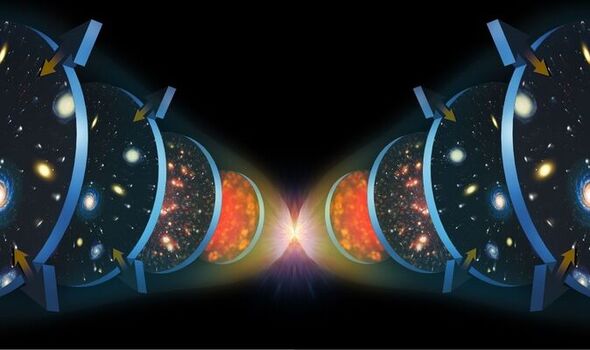Physicists suggest that there could be an anti-universe twin existing on the opposite side of the Big Bang within our universe.
In a new cosmological model of the universe proposed by the physicists of Canada it has been said that there is possibility of existence of an earlier antimatter universe before the big bang and the present universe is an antimatter counterpart of it. This model brings into play an idea of an “antiuniverse” which, alongside the universe we are a part of, maintains the phenomenon of CPT symmetry. Despite the remaining loopholes in this theory, the authors contend that it is a rational account of the existence of dark matter.
Neil Turok, of the Perimeter Institute for Theoretical Physics in Ontario, is equally scathing about current models which he says resemble Ptolemy’s description of the solar system in that they rely on fiddled parameters. Inflation is one such parameter described by Turok as a way of explaining why the large scale structure of the universe is relatively uniform. In this he proposes that the traditional method of introducing new particles or fields in order to explain new phenomenon might not be the best approach to explaining the universe.
Turok and his colleague Latham Boyle from the Perimeter Institute opted to build a model of the universe using only known particles and fields to explain all phenomena. Their goal was to check if the universe can continue beyond the Big Bang, beyond which general relativity does not apply to, and if it goes the other way as well. Turok goes further to say, “We found out that such an extension exists. “
Their solution was to adopt the assumption that the whole universe has CPT symmetry. This fundamental principle states that if the space is reflected, time is reversed and particles are replaced with their respective antiparticles, then all the physical laws remain the same. Nonetheless, according to Turok, this principle cannot apply to the universe that we know, where time goes forward, space expands, and matter dominates the antimatter.
In its stead, Turok avows that a pair of a universe and an antiuniverse is what sustains this parity. Turok further explained that the antiuniverse would expand larger and further back in time from the Big Bang, made up of antimatter and having spatial properties that are opposite to that of our universe. This is similar to the creation of electron-positron pairs in a vacuum.

According to Turok and Kieran Finn of Manchester University in the UK, many more improvements need to be made on the model and many people will have something to say about it. He notes that when submitting the paper to Physical Review Letters for review and after many discussions with the referees, they discussed the temperature fluctuations of the cosmic microwave background. According to Turok, the referees wanted to know why there are fluctuations, to which they said, it’s not fully optimized yet. In the end, the referees agreed with their reasoning.
In Turok’s view, the fluctuations can be explained by the quantum-mechanical characteristics of the space-time near the Big Bang singularity. However, the fixed points are located in the far future of the universe and the far past of the antiuniverse, while all quantum-based variations are possible in between. Turok and his colleagues calculated the number of times each possible configuration might occur and found out that what is most likely to exist is a particular CPT pair configuration. He says that the most likely universe is the one that is similar to our own.
Turok goes further to argue that due to issues such as free will, quantum uncertainty of the universe is not a mirror image of an antiuniverse.
However, as Turok points out, the new model provides a much more logical rationale for dark matter. The candidate for being dark matter is a “sterile” neutrino – an extremely light and very massive particle that could provide left-handed neutrinos with their finite mass. According to Turok, CPT symmetry enables one to determine why there are so many right-handed neutrinos in the universe. Given the observed density of dark matter, the mass of right-handed neutrino is approximately 5×108 GeV, which is 500 million proton masses.
Do not forget to share your opinion with us to provide you with the best posts !




0 Comments